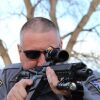Firearms training, as with everything in law enforcement, is often decades of tradition unhampered by progress. As my friend and renowned law enforcement trainer, Chuck Haggard, says, law enforcement training and culture needs, “a hard reset.” I couldn’t agree more.
Since the turn of the century, we’ve learned so much about the human brain and how it learns, perceives and recalls information. Still, we’re stuck in the same routines, teaching the same techniques using the same training methods that we did in the 1900s. It’s time for a change. Here what we should fix first.
| DOWNLOAD OUR FREE RESOURCE: How to buy firearms training equipment
Pointing is rude
Most instructors teach some variation of the four basic safety rules credited to Col. Jeff Cooper:
- Treat all guns as if they were loaded.
- Don’t let the muzzle cover anything you are unwilling to destroy.
- Keep your trigger finger off the trigger until you are ready to fire.
- Be sure of your target, what’s behind it and what’s around it.
For the record, I teach safety a little differently, and in much more depth, but you get the idea.
Think about your firearms training and the safety rules you were taught. No matter who taught you, I guarantee you were taught something similar to rule #2. Yet, we see officers pointing guns at suspects time and again in body camera footage of actual incidents. I’m certain the reason this happens is due to these officers’ basic peace officer academy training. Academies hammer on the above safety rules, but usually end up allowing cadets to point their simulated firearms at role players who are non-threats during force-on-force training.
I’ve been percolating on this thought since I read Steve Harris’ 2016 article, “Too Much Gun Pointing,” in Modern Service Weapons. Please take a few minutes to read it.
Why?
When I ask both trainees and instructors why they feel the need to point a gun at a potential threat prior to making the decision to fire, the answer is always “it’s faster” or “low ready is no ready.” Is that a legitimate argument?
Force Science Institute conducted a study comparing the time it takes for the average officer to raise a firearm, acquire a sight picture and fire one round from two positions:
- Low ready (pistol extended out and downward at a 45-degree angle and not pointing at the target)
- Tactical low ready (pistol extended out and downward at a 30-degree angle and kind of pointing at the target).
The times were almost exactly the same.
I took that information and ran my own unofficial experiment. I measured how long it took from the timer’s beep to successfully firing a round into the center ring (not the large qualification ring) of an Oklahoma-approved GM-2002PH-2 target from both the low ready position and starting with my sights on the target. My trigger finger was kept “in register,” (high up on the slide of the pistol) until the decision was made to fire.
It takes time to take our trigger finger out of register and place it on the trigger upon making the decision to fire (unless you’re violating that rule as well). It also takes time to raise the gun from the ready position to the target. How much time? For me, the times were almost precisely the same and those movements happen simultaneously. Therefore, there is no speed advantage to be gained from violating this safety rule. My apologies to the “low ready is no ready” crowd, but that old trope just does not pan out.
| COMPLETE GUIDE: How to buy firearms products
Advantage/disadvantage
If there are no chronological advantages to pointing a gun at someone before the decision has been made to fire, what are the disadvantages?
Obviously the first is safety. Cops sometimes shoot people they shouldn’t. Those incidents are horrific and unacceptable, obviously. They often end with cops in prison or financially broken or both.
It’s obvious to me that many of those tragic events happen because the officer was focused on their firearm’s sights (while pointing their gun at the subject). That’s the advantage of the low ready position. You have no temptation to focus on your sights. Most importantly, you can see what your suspect is doing. Is he reaching for something or just moving? Is that a gun or a wallet, cell phone, etc.? You might not know if your gun is in your line of sight.
Science and stuff
Dr. Paul Taylor, a former officer who’s now an assistant professor of Criminal Justice at the University of Colorado-Denver and a figure of rising prominence in the field of deadly force dynamics. did some great work on this topic as well. His study, “Engineering Resilience into Split-Second Shoot/No Shoot Decisions: The Effect of Muzzle Position,” used 313 volunteer officers of varying skills and ages. The testing methods and results are well explained in Erick Gelhaus’ article in American Cop, “Ready Positions and Better Outcomes.”
Life-altering decisions
I’ve made this argument several times to other cops and trainer, but still encounter resistance, though I’ve never been presented with a counterpoint that changed my mind. When I press further, these officers usually just say something to the effect, “I just want that advantage.” In other words, it’s most likely just an emotional pacifier; one with potentially life-altering consequences. As always, don’t take my word for it. Go to the range with a timer and do your own research. I don’t blame this officer in the video below. I blame the law enforcement training culture and its failings.




